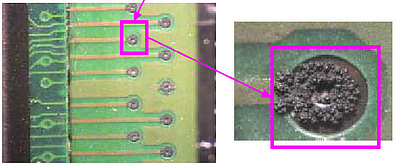 Where the icky brown rusty corrosion is easy to see on ferrous metals (steels; iron based), corrosion on non-ferrous metals is less visually intrusive, but may be more debilitating. The electronics industry uses both ferrous and non-ferrous metals in their manufacturing. Many of the chassis and support structures may be made of steel, but the conductive non-ferrous metals used for electron pathways are typically copper, silver, aluminum, and/or their alloys.
Where the icky brown rusty corrosion is easy to see on ferrous metals (steels; iron based), corrosion on non-ferrous metals is less visually intrusive, but may be more debilitating. The electronics industry uses both ferrous and non-ferrous metals in their manufacturing. Many of the chassis and support structures may be made of steel, but the conductive non-ferrous metals used for electron pathways are typically copper, silver, aluminum, and/or their alloys.
Here are four problems that can occur from corrosive reactions to the non-ferrous metals in electronics and their assemblies:
- 4. Burnouts – As metals corrode, they change from being conductive to insulative. This change may place stresses at points in the circuit where there is resistance because of corrosion; heat can build up and blow the circuit. As electronics become smaller in scale, corrosion become a a bigger challenge to maintaining their reliability.
- 3. Bad Solder Joints – Solder does not adhere well to metals with corrosion on the surface. Traditionally, the electronics industry has cleaning operations strip any oxidation off the metals prior to soldering (joining circuits). Now, with environmental standards becoming more stringent, some of the more robust solders and cleaners are no longer used or only on a limited basis.
- 2. Increased Electrostatic Discharge Damage – A Bell Labs study showed that as oxidation layers accumulate on the conductive metals, there is an increase in recognizable ESD events and their intensity. Since corrosion is an insulator and small built-up static charges can’t transfer through the corrosion, the static charges potential will grow to higher levels, thus becoming dangerous strikes when they jump across, either blowing the circuit or creating weak points.
- 1. Intermittent Defects – This is a failure that shows itself intermittently. The product doesn’t work, but at the time of analysis the product works fine and the failure cannot be replicated. Corrosion will cause the product to react differently with various atmospheric conditions. The relative humidity may vary between the time of the problem and the time of the analysis.
The costs of these problems increase as the product travels through its development stages (rule of 7 times more expensive); it is best that the corrosion problem be addressed from the beginning to the end. Strong corrosive barrier packaging protection is a solution to these problems; wrap the electronics in a “protective skin” early and from start to finish.
More from our series on the corrosion of electronics, the more specific topic of aluminum corrosion and the related topic of pitting corrosion.
|
More about corrosion in this video:
|
And about Intercept Technology™ in this one:
|
 |
 |
Intercept Technology Packaging products fit within a sustainability strategy because they are reusable, recyclable, do not contain or use volatile components (No VOCs, Not a VCI) and leave a smaller carbon footprint than most traditional protective packaging products.
Liberty Intercept Blog
4 Failure Modes Affecting Electronics
Posted by Joe Spitz on May 10, 2011 5:49:00 AM
Here are four problems that can occur from corrosive reactions to the non-ferrous metals in electronics and their assemblies:
The costs of these problems increase as the product travels through its development stages (rule of 7 times more expensive); it is best that the corrosion problem be addressed from the beginning to the end. Strong corrosive barrier packaging protection is a solution to these problems; wrap the electronics in a “protective skin” early and from start to finish.
More from our series on the corrosion of electronics, the more specific topic of aluminum corrosion and the related topic of pitting corrosion.
More about corrosion in this video:
And about Intercept Technology™ in this one:
Intercept Technology Packaging products fit within a sustainability strategy because they are reusable, recyclable, do not contain or use volatile components (No VOCs, Not a VCI) and leave a smaller carbon footprint than most traditional protective packaging products.
Topics: corrosion, reliability, labor cost, reduce costs, quality assurance, electronics corrosion
Related Posts
Condensation and Corrosion Control: Protect Product Integrity
Corrosion via Corrugate
What is Corrosion?
Leave a Comment